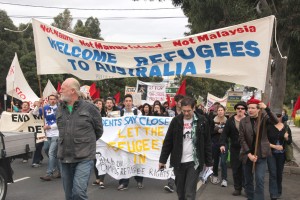Australian Refugee Policies Spark Controversy
Australia’s alleged cruel treatment towards its growing number of refugees residing in government-officiated detention centers has recently come under scrutiny as the national media has highlighted poor living conditions for children in the camps. For example, the story of a baby recently sent back to Nauru’s detention center despite her need for medical attention has sparked an active dialogue to force the Australian government to rethink its refugee policies. Australia’s current refugee and detention policies were initially responses to the mass dispersion from the Vietnam War. According to the Parliament of Australia’s website, an estimated 1.8 million people left Vietnam in 1975. However, only about 2,000 of those people landed in Australia. The Australians welcomed the refugees, but domestic concerns soon arose, such as increasing unemployment and refugees “jumping the immigration queue.” In the late 1970s, Australia built its first three immigration detention centers in Sydney, Perth, and Melbourne. Mandatory detention was introduced in 1992 when the government passed the Migration Amendment Act of 1992. The law was originally geared to extend only to certain situations, but it soon covered all “unlawful” citizens.
Since their inception, Australia’s detention centers have become increasingly crowded with a continuous flow of immigrants seeking asylum. As of 2012, immigrants who arrive by boat are processed on either Nauru or Manus Island. If they receive asylum, they can choose to live on those islands or be sent to Cambodia. The government’s main goal is to cut down on people smuggling, and the new procedures to stop every boat are accomplishing this objective.
According to the Australian Human Rights Commission’s immigration detention statistics, there are a total of 1,852 people in Australian immigration detention facilities, 104 of whom are children. In Nauru, there are 543 asylum seekers, including 70 children.
However, living conditions in Nauru are rudimentary, and people are barely given proper necessities. Sanitation and hygiene problems are rampant as the centers are infested with rats and other insects. Not only is there lack of care, but there also have been security breaches within the camps. A 2015 Final Report from Australia’s Parliament cites accusations of both sexual and physical abuse. Those most at risk in these poor conditions are children. Brian Owler, president of the Australian Medical Association, petitioned the government to release all children from offshore and onshore detention centers. The 2014 Human Rights Commission report shows that children suffer from large amounts of mental, physical, psychological, and development distress.

Though little attention has been given to this issue due to the Nauru government’s ban on journalists, powerful stories are emerging that shine some light on the matter. The Australian government must now think of a careful response to address this contentious problem.
